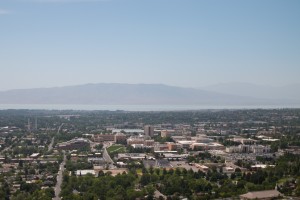
Utah County received a “C” rating in air quality according to a study done by the American Lung Association. The grade has dropped from the “B” the county received last year.
Salt Lake City received an “F” rating in both 2013 and 2014, and only one city in Utah received a rating that was above a “C” in 2014. With the air quality in Utah worsening, legislators are looking into possible solutions.
“Maintaining our shared resource of clean air is critical to the public health of our citizens as well as tourism and business development,” claimed Rep. Becky Edwards, who recently pushed for a bill that would increase air quality regulations above that of current Environmental Protection Agency (EPA) regulations.
Those in opposition to the bill claim that there have not been enough comments from the industry and that this bill could be a potential job killer.
“Industry doesn’t support it,” said Rep. Michael Noel, chairman of the Natural Resources, Agriculture and Environment Interim Committee.
However, air quality regulations do not just affect the job market. Breathe Utah, an organization dedicated to improving air quality in Utah, says ozone can cause serious health risks.
“Numerous scientific studies have linked ground-level ozone exposure to a variety of problems,” wrote Breathe Utah. Problems include “airway irritation, coughing and pain when taking a deep breath; wheezing and breathing difficulties during exercise or outdoor activities; inflammation, which is much like a sunburn on the skin; aggravation of asthma and increased susceptibility to respiratory illnesses like pneumonia and bronchitis; and permanent lung damage with repeated exposures.”
The American Lung Association adds to these concerns:
“Inhaling ozone may affect the heart as well as the lungs,” wrote the American Lung Association. “A 2006 study linked exposures to high ozone levels for as little as one hour to a particular type of cardiac arrhythmia that itself increases the risk of premature death and stroke.”
With risks like these, it is no wonder about two dozen bills relating to environmental regulations were discussed during the last legislative session.
The EPA is rumored to be working on new regulations that will decrease the amount of allowable pollution. While the exact amount that will be allowed is not yet clear, Utah isn’t likely to meet new, stricter standards.
“We are understanding of the fact that we have difficulty in even achieving the standards that are there by the EPA,” Rep. Edwards said.
She said that by increasing pollution standards, Utah will get ahead of the EPA and be able to have greater flexibility in how it regulates. She went on to say that Utah has unique geography and typography that necessitate the state’s ability to design its own policy rather than following the EPA’s “one size fits all” policy.
As the battle continues in the legislature, Utah Gov. Gary Herbert has created the Clear the Air Challenge to get Utah residents to think about their effect on the environment.
The challenge allows Utah residents to track their reduced impact on the environment by keeping track of carpooling, trip-chaining, public transit, bicycling and other alternative methods of transportation. The challenge features a leaderboard and can be taken as an individual or as an organization, with the winners at the end of the month receiving prizes.
“During the month-long Clear the Air (initiative), we encourage Utahns to drive less and drive smarter to reduce vehicle emissions and collectively improve Utah’s air quality. Each trip saved makes a difference to the quality of our air,” said Jonathan Johnson, chair of the board of Overstock.com, a sponsor of the initiative.
The initiative’s goal is to engage 10,000 participants and to cut back 300,000 single vehicle trips and 2 million miles.
“The Clear the Air Challenge is the perfect opportunity for people in Salt Lake City, Ogden, Logan, Provo, Moab, St. George — everywhere,” said Amanda Smith, executive director of the Utah Department of Environmental Quality. “We all need to think about how we travel and how it impacts the air we breathe.”
The American Lung Association has given suggestions for those areas that have received low ratings.
“Drive less. Use less electricity. Don’t burn wood or trash,” the list said. “Support measures in your community that can cut air pollution. Tell your local and state officials to take steps to clean up air pollution. Send a message to the EPA, President and members of Congress to tell them we need them to support cleaner, healthier air.”




